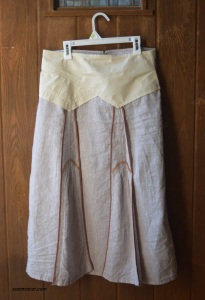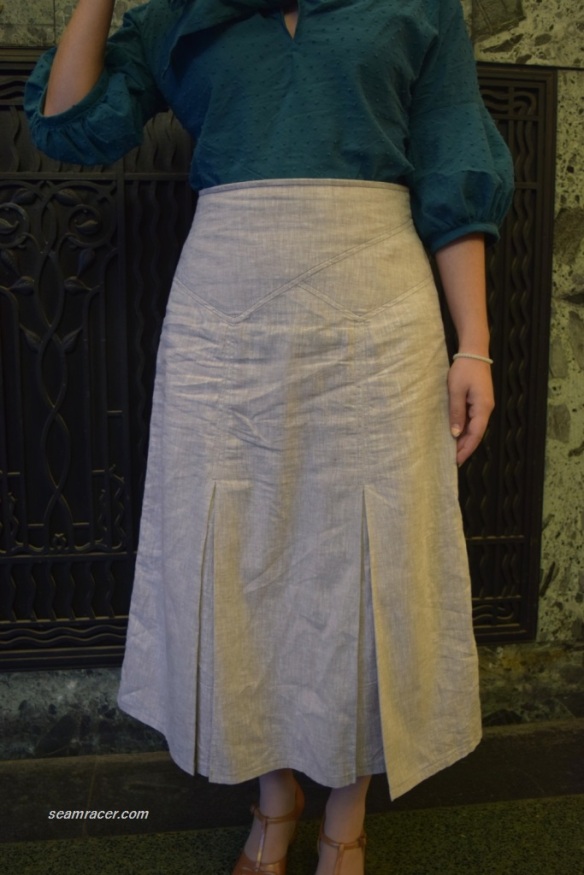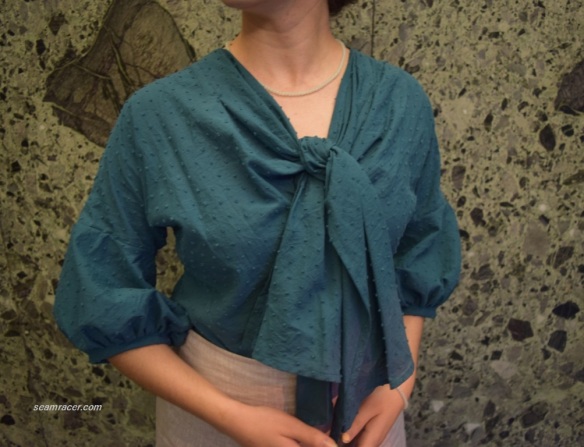With all my recent criticism of modern “Big 4” pattern companies’ reprints of old original patterns, my budget is nonetheless limited when it comes to buying all the old sewing patterns I would like. (Guess you can tell my ideas are bigger than my budget!) Thus, in the spirit of being open-minded as well as needing a resource for more variety of past years to sew from, I do still use the re-releases with some misgivings. Recently, in my effort to understand and sew the early 1930’s, I have used two of the first releases from McCall’s “Archive Collection” – a skirt and tie-front blouse for an ensemble from 1933, worn with my vintage 30’s Dr. Scholl’s brand shoes.
Both pieces, and particularly the blouse, do have the classic 30’s look of easy sophistication with ‘simplicity-yet-smartness’ of its design. Both are feminine and flowing yet a bit structured in their own way. The blouse is one of the many designs of the early 30’s which had interest going on over both the chest and neckline (visit my Pinterest page for some visual examples). Adding such details gave illusionary body lines, as well as ways to play with dramatic, inventive, interesting, or just plain weird ideas of how many ways to avoid a plain fronted blouse or dress. This skirt, as well as my previous 1930’s skirt, is in line with the style of Lucien Lelong, who in 1925 debuted his “kinetique” line of clothing. Lelong over saw the creation of slim silhouettes with inset pleats that would pop open when the wearer was in motion but fall back into place at rest (quote from page 82 of the 2014 book of the FIT museum exhibit, “Elegance in a Time of Crisis, Fashions of the 1930s”). This outfit is from the beginning of “sportif” clothing – the first modern means of dressing with both comfort and style for a new-to-the-30’s type of female…an active, independent, and collectively important woman.
THE FACTS:
FABRIC: The Blouse – a 100% cotton Swiss dot fabric in a deep dusty peacock turquoise color;  The Skirt – a heathered tan oatmeal-colored 100% linen
The Skirt – a heathered tan oatmeal-colored 100% linen
PATTERNS: McCall’s #7053 for the blouse and McCall’s #6993 for the skirt, both “Archive Collection” patterns circa 1933
NOTIONS: I used all of what was on hand – a vintage metal zipper for the skirt, vintage bias tape given to me from my Grandmother for the skirt, as well as thread and interfacing that I had already.
 TIME TO COMPLETE: Pretty darn quick – the blouse came together in 4 or 5 hours and the skirt in about 5 or 6 hours. The first was done on September 23 and the second on September 26, both in 2016.
TIME TO COMPLETE: Pretty darn quick – the blouse came together in 4 or 5 hours and the skirt in about 5 or 6 hours. The first was done on September 23 and the second on September 26, both in 2016.
THE INSIDES: The blouse inside is left raw (it doesn’t fray) and the skirt is clean inside with all bias bound edges.
TOTAL COST: Both fabrics were bought when Hancock Fabrics was going out of business so both fabrics were only a few dollars a yard. My total is probably about under $20.
I am quite happy with my finished outfit. My all over outfit is completely authentic to the times with the fabrics I chose (especially the Swiss dot), the colors will span seasons and match well with what else I have in my closet, and the fabric textures add interest. Early 1930’s patterns from the time of the NRA are expensive (to me), a bit harder to come by, and considered more collectible (at least from what I see) so this outfit is a welcome and oh-so-very wearable addition to my wardrobe of this decade. I am itching to make the other long sleeve cowl neck view on the blouse pattern – it looks just as practical yet lovely for my growing amount of 30’s clothing!
However, I do have lingering doubts that these are 100% true carry-overs of 30’s patterns as they are quite fabric hogs. I know the 1930s patterns demanded more fabric than a 1940s pattern, but this was still Depression times and almost 3 yards for a blouse seems like almost too much. I am not certain my claim is worthwhile because this was the era of both an aura of elegance and superficial extravagance, even if only to “keep up appearances”. I have read other bloggers who have mentioned  this seeming incongruity of era and fabric demand seen on the envelopes. These 1933 pattern re-issues also include a vest and a jacket, but each were released as their own individual pattern. (Why? To make us spend more money? It’s quite rude to do this for the Archive Collection when the regular patterns have sets in one piece!) I am guessing this whole 4-piece suit could have been in one complete pattern set originally – this was common practice in the early to mid-1930s. I have yet to find the original for these patterns, so for all I know I’ll have to believe McCall’s…for now.
this seeming incongruity of era and fabric demand seen on the envelopes. These 1933 pattern re-issues also include a vest and a jacket, but each were released as their own individual pattern. (Why? To make us spend more money? It’s quite rude to do this for the Archive Collection when the regular patterns have sets in one piece!) I am guessing this whole 4-piece suit could have been in one complete pattern set originally – this was common practice in the early to mid-1930s. I have yet to find the original for these patterns, so for all I know I’ll have to believe McCall’s…for now.
I did have some problems with the fitting of both pieces – they seem to lack good fitting in odd places and run quite large! I needed to dramatically take in both the blouse and skirt as well as add more darts and shaping. Generally, I made the same sizes I would have chosen had these been McCall’s traditional modern pattern, and the blouse and skirt are not the same as them nor are they the fit of old 30’s patterns I have sewn up before.
First of all, the skirt needed more curving added in to both make the hips and waist smaller and more fitted. Even with an extra two inches taken out, I still could have taken out more and curved in the waist better because it has a weird placement on me. I sewed my “normal” McCall size – that’s what makes this fit so weird. Since the waist is not fitted to my body while the hips fit better, this skirt hangs from the hips while the waist kind of floats in place. Anyway, it is comfy being loose, and what I feel with the fit is (I think) not noticeable on me. The cover drawing makes it look like the waistband panel should be snug and at a high point across the middle…I wish I would have achieved that with my version. I tried to do so, I really did.
Secondly, the blouse’s shoulders were incredibly droopy on me. As the perfect fix, the back of the blouse has a Y-shaped dart system where the horizontal “arms” of the Y come up and over my shoulders and down into the wrap front. The blouse is designed with a Y paneled front, why not do it to the back when it is the best option to achieve a well-fitting blouse? Of course, this blouse is supposed to be loose and kind of baggy, but too much hanging in the wrong places and a garment just appear poorly made. Once ironed, my Y darts became invisible – yay – and each dart picked up the shoulder by an extra 2 inches to make the lantern sleeves puff out over my elbow right where they should be.
 When the front wrap ends are held out they look like some sort of wings. I think they are pretty and a good kind of different but having a blouse with fabric hanging down the front does take a little getting used to. When I sit down at a table with food in front of me, I have to remember to place my arm across my front to keep my blouse’s fabric from dipping into the plate and making a mess. The same thing goes for being over a sink to wash my hands. I have heard this pattern design referred to as always wearing a napkin under your chin to catch any mess and generally be in the way. I do not think it is as bad as that – the wrap front with its hanging ties can be tacked down permanently if you would so like because you do not need to undo it to put the blouse on oneself. This doesn’t need any zipper or closure, for goodness sake! For as easy to make as it was and as lovely a blouse as it is, this pattern is definitely worthwhile…as long as you’ve got 3 yards of fabric for it.
When the front wrap ends are held out they look like some sort of wings. I think they are pretty and a good kind of different but having a blouse with fabric hanging down the front does take a little getting used to. When I sit down at a table with food in front of me, I have to remember to place my arm across my front to keep my blouse’s fabric from dipping into the plate and making a mess. The same thing goes for being over a sink to wash my hands. I have heard this pattern design referred to as always wearing a napkin under your chin to catch any mess and generally be in the way. I do not think it is as bad as that – the wrap front with its hanging ties can be tacked down permanently if you would so like because you do not need to undo it to put the blouse on oneself. This doesn’t need any zipper or closure, for goodness sake! For as easy to make as it was and as lovely a blouse as it is, this pattern is definitely worthwhile…as long as you’ve got 3 yards of fabric for it.
We kept with the time period with our background and went to take our pictures in the Continental Life Building. It is a scrumptious Art Deco gem which was built in 1930. It has had a tumultuous history and more recently saved from demolition by being turned into an apartment complex. The lobby that you see behind me is such an over-the-top way to give a visitor their first impression – so classic of the wonderful architecture of the 1930s. I just love the awe and tingling happiness it gives me to be in these types of buildings, especially when I’m in period clothing!
In the competitiveness and eagerness to move ahead and be “modern” it seems many towns, especially ours, glazes over architectural history as if it was a hindrance rather than a necessary link to connect us with the past. This can be the same situation when it comes to clothing styles seen in the stores to buy. Past fashion trends are always being re-used and re-hashed but once recognizing where they came from and why they were first used, the reason to admire or wear a new type of detail becomes a source of learning, knowledge, and sense of the bigger picture. (Hint – has anyone else seen a whole lot of 1930s era sleeves on the fashion scene since the last several months?! Check this out for one example.) Somehow, I feel like I’m doing both the building and my outfit due appreciation when I am able to pair a ‘me-made’ outfit with its time period counterpart place…and learn in the process. Also, I guess I’m just venting appreciation for every historical gem of a building that gets saved, just the same as for every vintage fashion trend treasure that gets re-made, re-worn, loved and respected anew.






